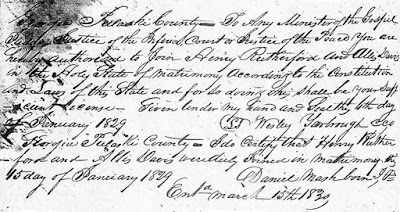Washington Memorial Library, Macon, GA
Henry and Alice were farmers. The family remained in Pulaski County until about 1844, when they migrated to the area somewhere along the Florida-Alabama state line (present-day Geneva County, AL and Holmes County, FL). In 1850, they were in Dale County, Alabama, near several associated families including Davis, Pate, Dawsey, Byrd, Cobb, and Underwood families. By 1860, Henry and Alice were living in the Mt. Ida neighborhood of Pike County, AL. The four oldest children were married. Two of them lived in Covington County, AL, one in Dale County and one in Escambia County, FL.
Henry died between 1860-1866, and son James died in the Civil War. In the following years, many family members, including Mother Alice, migrated to Texas (Amanda, Sarah, Cynthia and Samuel), and some later moved on to Oklahoma Territory. Others remained in Alabama and Florida (John, Abigail and Rachel), and one married and lived briefly in Georgia before bringing his family back to Henry County, now Houston County, Alabama (William Henry).
1 - Frances Amanda Rutherford b: Jan 1830 Pulaski County, GA d: 1916 Vinson, Harmon County, OK [11 children]
... + James Monroe Daniel b: Abt. 1825 Gadsden County, FL d: 20 Sep 1875 Roans Prairie, TX m: 18 May 1848 Dale County, AL Father: David Daniel Mother: Mary Rodgers. Military: CSA Alabama 57th Inf. Reg., Co. C; 22nd Inf. Reg., Co FL
2 - John A. Retherford b: 25 Nov 1833 Pulaski County, GA d: 1914 Holmes County, FL [5 children]. Military: CSA Alabama 53rd Reg., Mounted, Partisan Rangers, Co. D
... + Thursey Ann Pate b: 9 Jun 1832 SC or GA d: 30 May 1897, Geneva County, AL m: Abt. 1857 Dale County, AL Father: Alexander Pate Mother: Unknown (First marriage: Robert C. Floyd - 2 children)
3 - Rachel Rutherford b: Abt. 1836 Pulaski County, GA d: unknown [3 known children]
... + Howell S. Cobb b: Abt. 1829 AL d: 22 Jul 1864 in Civil War m: Abt. 1857 Covington County, AL Father: Stephen Cobb Mother: Lizzie. Military: CSA Alabama 57th Inf. Reg., Co. C
4 - Abigail S. "Abbie" Rutherford b: Nov 1840 Pulaski County, GA d: Aft. 1900 Citrus County, FL [7 children]
... + (1) John Lindsey Leavins b: 31 Jan 1831 Holmes County, FL d: 1863 m: Abt. 1856 Father: Richmond Leavins Mother: Nancy Martha Lindsey. Military: CSA Florida 11th Inf. Reg., Co. K; bur: Escambia, FL
... + (2) Smith S. Layport b: Abt. 1837 Pennsylvania d: Aft. 1875 m: 10 Aug 1867 Escambia County, FL Father: Smith S. Layport. Military: U.S. Marine Corps
5 - Sarah J. "Sally" Rutherford b: 26 Jul 1843 Pulaski County, GA d: 31 May 1905 Colbert, Bryan County, Indian Territory, OK [9 children]
... + Albert J. Gibson b: 3 Sep 1845 AL or MS d: 11 Jun 1921 Colbert, Bryan County, Indian Territory, OK m: 30 Dec 1864 Father: Unknown Mother: Sarah Gibson. Military: CSA Local Defense
6 - James Rutherford b: 1845 Alabama d: 1863 Chattanooga, TN.
Military: CSA Alabama 33rd Inf. Reg., Co. F; bur: Confederate Cemetery at Chattanooga
7 - Samuel R. Rutherford b: 18 Dec 1846 Alabama d: 22 Mar 1885 Alvarado, Johnson County, TX. Military: CSA Alabama 33rd Inf. Reg., Co. F [7 children]
... + (1) Susannah May Chester b: Abt. 1840 GA d: Abt. 1867 Pike/Crenshaw County, AL m: 4 Nov 1866 Pike County, AL Father: Asa C. Chester Mother: Lavonn __
... + (2) Mary Elizabeth "Lizzy" Clancy b: 24 Nov 1851 Pike County, AL d: 19 Dec 1942 Houston, TX m: 24 Dec 1873 Grimes County, TX Father: Alfred Joseph "Job" Clancy Mother: Sarah Elizabeth Ganey
8 - Cynthia Ann Rutherford b: 1849 Alabama d: 1889 Navasota, Grimes County, TX [8 children]
... + John B. "Jack" Brunson b: 1845 Alabama d: 1882 Navasota, Grimes County, TX m: 31 Dec 1866 Crenshaw County, AL Father: Albert Brunson Mother: Elizabeth Jenkins. Military: CSA Local Defense
9 - William Henry Rutherford b: 13 Mar 1851 AL d: 14 Feb 1887 Ashford, Henry County, AL (now Houston County) [7 children]
... + Hannah Elizabeth Dupree b: 11 Feb 1852 Pulaski County, GA d: 3 Jan 1935 Ashford, Houston County, AL m: Abt. 1869 Father: Daniel Thomas Dupree Mother: Sarah A. E. Berryhill
Data collected from many sources, but special thanks to Cousin Sandy from Chicago, who has spent many years researching the families named above. If you wish to exchange information with us, please email me.
















